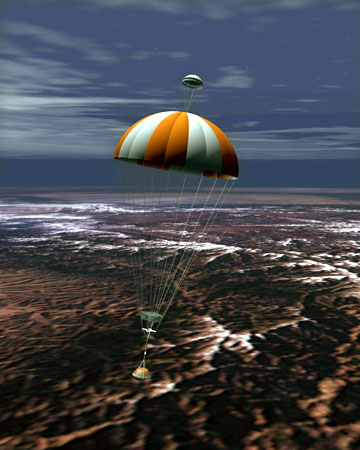 Alaskans Participating In
Stardust Re-entry Campaign
Alaskans Participating In
Stardust Re-entry Campaign
January 14, 2006
Saturday
The Geophysical Institute, University of Alaska Fairbanks, has
a professor and graduate student participating in the NASA hypervelocity
re-entry campaign for the Stardust sample return capsule.
 Artist's concept of
Stardust's sample return
Artist's concept of
Stardust's sample return
capsule parachuting down to Earth.
Image courtesy: NASA/JPL-Caltech
|
The Stardust vehicle will release
the capsule into Earth's atmosphere at 12:56 a.m. on Sunday,
January 15. The capsule, containing interstellar dust from the
Wild 2 comet, will re-enter at a whopping 28,600 miles per hour.
This re-entry is the fastest in NASA history.
Professor of Geophysics Hans
Nielsen and graduate student Takashi Kammae, both of the Geophysical
Institute, are monitoring the capsule's ablative heat shield
during re-entry. The heat shield has never been flown before,
but is designed to absorb the intense heat generated during re-entry
into the atmosphere. If it performs well, it's engineering could
be replicated for return vehicles that contain crews. Nielsen
and Kammae will monitor the heat shield aboard NASA's DC-8 aircraft,
an airborne laboratory full of instruments. There, they will
observe data collected by a high-speed imager, designed at the
Geophysical Institute for auroral research.
"Our whole mission is
to look at the engineering of the return capsule," Nielsen
said. "This offers an opportunity to observe how the heat
shield performs under the specific conditions experienced during
re-entry. The performance of the material inside the heat shield
cannot be tested in the lab."
If the Stardust return capsule
survives re-entry, it will allow scientists to work with comet
dust. Cometary particles contain unique chemical and physical
information that may reveal the history of the solar system.
Related Stories:
Craft returning to Earth with specks
from space By KEAY
DAVIDSON - Pieces of a comet and dust grains from beyond the
solar system are headed toward Earth aboard NASA's Stardust spaceship,
and if all goes well early Sunday morning, the conical craft
should descend at nearly 29,000 mph in a blazing fireball over
Utah before making a soft, predawn landing in the desert.
Space agency scientists are
preparing to helicopter to the landing site to retrieve the capsule
after it has parachuted to the ground. The site is located on
an Air Force weapons test range. With luck, touchdown will occur
at 10 mph. - More...
Friday - January 13, 2006
Scientists looking to volunteers to
screen images for cosmic dots
By KEAY DAVIDSON - Thousands of volunteers are lining up - online,
that is - to help scientists analyze the first close-up pictures
of primal matter from beyond our solar system.
Over the past seven years,
invisibly small grains of interstellar dust have slammed into
slabs of lightweight material aboard the Stardust robotic spacecraft,
which is scheduled to fall back to Earth, landing in Utah, early
Sunday. - More...
Friday - January 13, 2006
On the Web:
http://stardust.jpl.nasa.gov/home/index.html
http://www.nasa.gov/mission_pages/stardust/multimedia/index.html
Source of News:
Geophysical Institute
http://www.gi.alaska.edu
E-mail your news &
photos to editor@sitnews.us
Publish A Letter on SitNews Read Letters/Opinions
Submit
A Letter to the Editor
SitNews
Stories In The News
Ketchikan, Alaska
|

